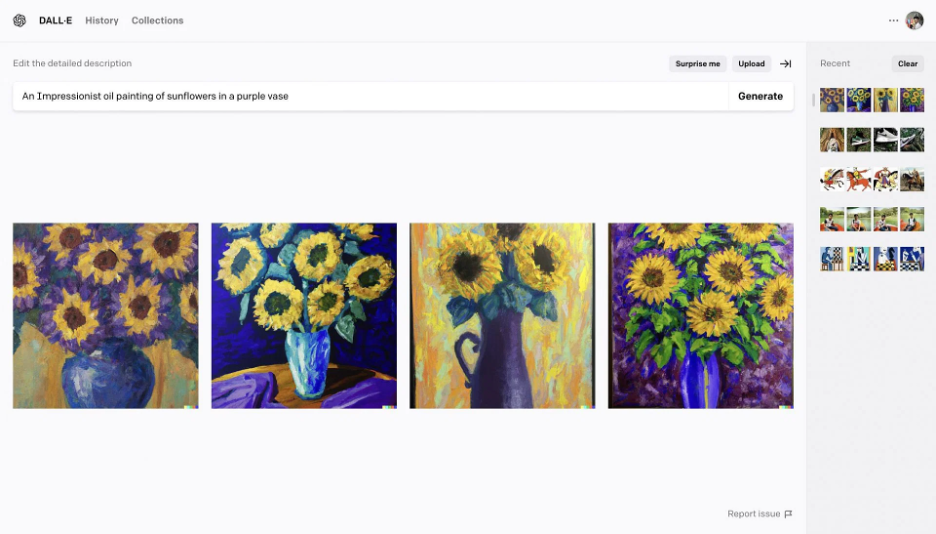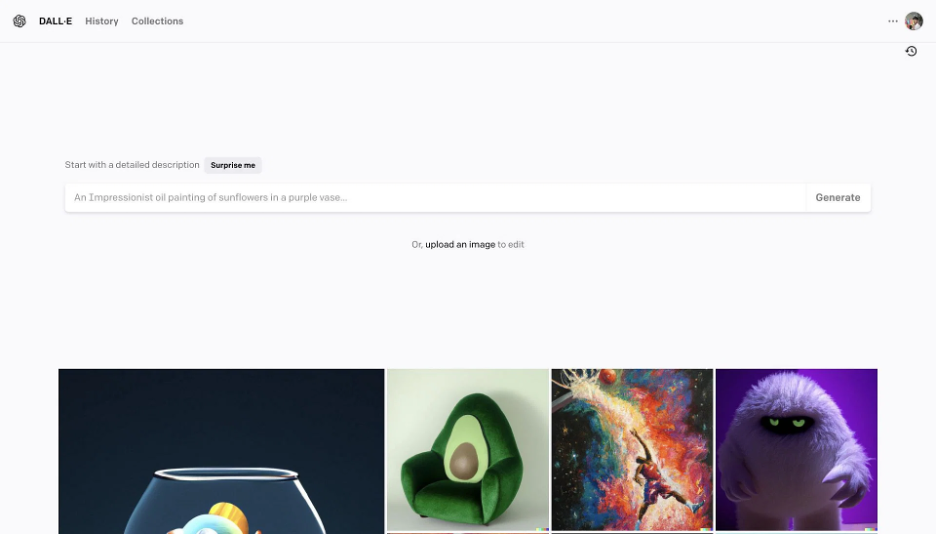DALL-E: AI at the Intersection of Art and Technology

If you ask the AI system DALL-E to generate an Impressionist oil painting of sunflowers in a purple vase, the results surprisingly vary wildly. With results ranging from blue vases to yellow peonies, the technology utilized in generating these images showcases a disparity between intention and representation. When inputting commands into programs such as DALL-E, the visual intrigue and question of style remain. Why can DALL-E interpret only certain requests? And why are results sometimes skewed when the technology has access to billions upon billions of reference images?

The Digital Humanities series organized by the University Libraries at The Ohio State University presented an examination of AI and Visual Culture to answer these questions. AI, or artificial intelligence, is a technology that is developing at a fiercely rapid pace. While speaking in the ironically digital setting of Zoom, Dr. Amanda Wasielewski introduced her research within the field of generative AI. Dr. Wasielewski is the Associate Senior Lecturer of Digital Humanities at Uppsala University in Sweden. With her framework grounding her within the world of art, the information she presents is perfectly entwined and contextualized within both the realms of art history and forthcoming technology.
Dr. Wasielewski’s recent work, Computational Formalism: Art History and Machine Learning published by MIT Press, encompasses understanding art history in terms of computer vision. The art historian defines computer vision, or CV, as a field in which images are categorized and analyzed through automated computational means. A subfield of this area of study is computational visual analysis, in which researchers attempt to automate the interpretation and understanding of visual material, connecting the technology with a sense of art historical analysis. In other words, scholars are working to understand how asking AI to generate sunflowers in a purple vase relates to how it then identifies the color purple and the style of Impressionism into creating an image.

Art historian Alois Riegl was one of the first within the field to put forward the notion of formalism in terms of studying artwork. Formalism, as a method and in theory, is the act of taking into account the physical aspects of an artwork with minimal regard to contextual and historical precedent. In the nineteenth century, Riegl became an influential proponent of using formalism to analyze art. Within the nineteenth-century context, art historians had to manually compare images, greatly contrasting the immediate gratification of modern technology, where anyone can analyze millions of images simultaneously. This methodology is key to understanding AI technology and its purpose, which Dr. Wasielewski works to define.
Understanding generative AI and its comprehension of art relies on understanding how the technology functions. In its current state, computational analysis utilizes a formalist method. Analyzing form refers to studying artistic elements such as the purple of a vase, sunflowers as an object, or blue as a background. The two components of generative AI are the content and object of the work and its style. What Dr. Wasielewski strives to understand through her research is the machine’s capability to create an intrinsic connection between surface-level observation and a deeper-level analysis, such as understanding context and subject matter. In terms of the DALL-E generative system in particular, the style is analyzed in terms of historical context, technique, and materiality. With the sunflower example, the description language mentions the Impressionistic style. The AI can distinguish the Impressionist period as well as the techniques it's accompanied by, like its broad strokes and pastel color palette. Style, as understood by generative AI, is orphaned without its object. DALL-E generates art as separate from subject and subject matter.
Dr. Wasielewski’s research establishes a precedent within the scholarship of art history. With her research, she introduces another branch of study to analyze works within the field. Being able to identify works produced by generative AI is another way to identify the subject matter, intention, and historical context—or lack thereof. Dr. Wasielewski’s development of this perspective continues as the field of AI technology itself rapidly evolves. The work she puts forward is exemplary of interdisciplinary study, reaching both into the fields of art and science technology. Scholarship is gained from the interlinking of work from both fields of study.

Though the technology attempts to reimagine works within its stylistic context, AI-produced images are unable to directly replicate what artists intend. The zeitgeist of works produced by the hands of humans can’t be replicated outside of the context in which it is conceived. Dr. Wasielewski mentions an example provided by contemporary computational linguist Emily Bender: If two people are stranded on two separate islands and their only means of communication is an octopus, the octopus could mimic directions back from person A to person B, but it would never reach a level to which it can fully understand what the humans are trying to say. Understanding the bounds and limitations of what generative AI can achieve is integral to identifying its artistic intentions. Though DALL-E acts as a limitless tool for generating imagery for multiple purposes, what can be created by the human mind can never be replicated by machine.
More information about events from the Research Commons at OSU can be inquired about at their email, researchcommons@osu.edu.

